
International Journal of Bridge Engineering
Scope & Guideline
Advancing Infrastructure: Pioneering the Future of Bridge Engineering
Introduction
Aims and Scopes
- Sustainable Bridge Design and Construction:
Research emphasizing sustainable practices in bridge design, including the use of eco-friendly materials and techniques to minimize environmental impact. - Structural Analysis and Assessment:
Studies focusing on the structural integrity and assessment of existing bridges, including methodologies for evaluating their safety and performance under various conditions. - Seismic and Dynamic Response Analysis:
Investigations into the seismic performance and dynamic responses of bridges, particularly under extreme loading conditions such as earthquakes and wind. - Innovative Materials and Techniques:
Exploration of new materials, such as composites and advanced concrete, and their applications in bridge engineering to enhance durability and performance. - Modeling and Simulation Techniques:
Development and application of various computational models and simulation techniques for predicting the behavior of bridge structures under different scenarios.
Trending and Emerging
- Sustainable Engineering Practices:
A significant increase in research dedicated to sustainable design frameworks for bridges, emphasizing environmental considerations and long-term viability. - Advanced Composite Materials:
Growing interest in the use of composite materials in bridge engineering, reflecting a trend towards lightweight, high-strength solutions that enhance structural performance. - Dynamic and Seismic Analysis:
An uptick in studies focusing on the dynamic response and seismic fragility of bridges, underscoring the importance of resilience in infrastructure amidst climate change and natural disasters. - Innovative Construction Methods:
Research into new construction techniques and modeling approaches, including the use of robotics and advanced simulation tools to improve efficiency and safety during the construction of bridge structures. - Holistic Assessment Approaches:
Emerging themes around comprehensive assessment methodologies for existing bridges, integrating modern technology and data analytics to enhance maintenance and safety protocols.
Declining or Waning
- Terrorism Impact Studies:
Research related to the effects of terrorist actions on bridge structures has been less prominent in recent publications, suggesting a shift towards more technical and engineering-focused studies. - Human-Powered Engineering Concepts:
The exploration of human-powered mechanisms, such as flywheel-driven concrete mixers, has seen a decrease, possibly reflecting a transition towards more mechanized and automated construction technologies. - Traditional Materials and Techniques:
There has been a noticeable decline in studies focusing on conventional materials and methods, as the field increasingly embraces innovative materials and contemporary engineering practices.
Similar Journals

Bridge Structures
Building Knowledge Bridges in Structural EngineeringBridge Structures is an esteemed academic journal dedicated to the field of structural engineering, particularly focusing on the design, analysis, and maintenance of bridge systems. Published by IOS PRESS, a reputable publisher known for its contributions to various scientific fields, the journal serves as an integral platform for disseminating innovative research and advancements within the domain. With an ISSN of 1573-2487 and an E-ISSN of 1744-8999, Bridge Structures has established itself over the years—covering contributions from 2005 to 2024. The journal has attained a commendable ranking within the Q3 category in Building and Construction and holds a position within the 28th percentile among its peers according to the Scopus rankings. Though the journal operates on a subscription basis, its commitment to advancing engineering knowledge is paramount, making it essential reading for researchers, practitioners, and students eager to deepen their understanding of bridge engineering. The journal not only explores theoretical advancements but also emphasizes practical applications, providing a well-rounded perspective on current challenges and solutions in the field of bridge structures.
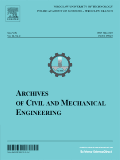
Archives of Civil and Mechanical Engineering
Connecting Ideas, Inspiring Engineering ProgressArchives of Civil and Mechanical Engineering is a distinguished peer-reviewed journal published by SpringerNature, focusing on advancing the fields of civil and mechanical engineering. With an impressive Q1 ranking in both categories in 2023, this journal caters to a global audience, addressing the evolving challenges and innovations within these vital engineering disciplines. The journal has been a pivotal platform since its inception in 2006, and it continues to be essential for researchers and practitioners seeking to publish and access high-quality research. The absence of an Open Access option ensures that published works maintain rigorous academic standards, thereby enhancing their value within institutional repositories. With a robust impact factor and high visibility on Scopus—ranking #122 out of 672 in Mechanical Engineering and #74 out of 379 in Civil and Structural Engineering—this journal is an ideal venue for professionals, researchers, and students dedicated to advancing their knowledge and contributing to cutting-edge engineering practices. Based in Germany and operating internationally, the Archives of Civil and Mechanical Engineering invites submissions that address critical issues and solutions in contemporary engineering.
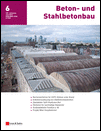
Beton- und Stahlbetonbau
Unveiling Breakthroughs in Structural EngineeringBeton- und Stahlbetonbau is a renowned journal published by ERNST & SOHN, dedicated to advancing knowledge in the field of building and construction, particularly focusing on concrete and reinforced concrete engineering. Established in 1969, this peer-reviewed publication encompasses a broad range of topics, including innovative construction methods, structural analysis, and material performance, making it a crucial resource for researchers, scholars, and industry professionals alike. With an impact factor ranking it within the Q2 category in the Building and Construction field, this journal holds significant influence, evidenced by its Scopus rank of #112/223. Importantly, Beton- und Stahlbetonbau is committed to providing high-quality content that meets the academic rigor demanded by its audience, ensuring that readers remain at the forefront of technological advancements and research in concrete construction.
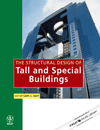
STRUCTURAL DESIGN OF TALL AND SPECIAL BUILDINGS
Shaping the Skyline with Cutting-Edge Insights.STRUCTURAL DESIGN OF TALL AND SPECIAL BUILDINGS is a prestigious journal published by Wiley that focuses on cutting-edge research and advancements in the field of structural engineering, particularly emphasizing tall and special structures. Since its inception in 2003, the journal has become an invaluable resource for academics and practitioners, showcasing innovative design methodologies, case studies, and theoretical contributions. With an ISSN of 1541-7794 and E-ISSN of 1541-7808, this esteemed publication holds impressive Scopus rankings, including Q1 in Architecture, making it a go-to source for the latest developments in engineering related to tall buildings and complex structures. The journal is known not only for its rigorous peer-reviewed articles but also for fostering a collaborative environment among professionals and researchers worldwide. Although it is not an open-access journal, readers from various disciplines, such as architecture, civil and structural engineering, and building construction, will find compelling insights that drive the industry forward. For those committed to excellence in structural design, STRUCTURAL DESIGN OF TALL AND SPECIAL BUILDINGS remains at the forefront of innovation and knowledge dissemination.
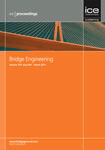
Proceedings of the Institution of Civil Engineers-Bridge Engineering
Exploring Sustainable Solutions in Bridge EngineeringProceedings of the Institution of Civil Engineers - Bridge Engineering, published by Emerald Group Publishing Ltd, is a pivotal academic journal that delves into the essential and dynamic field of bridge engineering and design. With an ISSN of 1478-4637 and an E-ISSN of 1751-7664, this journal serves as a vital resource for researchers, professionals, and students seeking to expand their knowledge and stay updated with the latest advancements and innovations in civil and structural engineering. The journal has demonstrated its relevance in the academic community with a current Scopus ranking of 101/223 in Engineering - Building and Construction and 193/379 in Engineering - Civil and Structural Engineering, both placing it in the Q3 quartile category. Despite its traditional publishing format, the journal remains a key platform for high-quality research from 2004 to 2024, especially for those interested in the intricacies of bridge development, maintenance, and sustainability. Ultimately, Proceedings of the Institution of Civil Engineers - Bridge Engineering aims to bridge the gap between theoretical knowledge and practical application, driving innovation and excellence in the realm of civil engineering.

Magazine of Civil Engineering
Connecting Research and Practice in Civil EngineeringMagazine of Civil Engineering, published by ST-PETERSBURG STATE POLYTECHNICAL UNIVERSITY, is a prominent open access journal dedicated to the field of civil and structural engineering. With an ISSN of 2712-8172 and E-ISSN 2071-0305, it serves as a vital platform for disseminating high-quality research, innovative methodologies, and current trends in building and construction. Since its inception in 2010, the journal has embraced open access, ensuring broad visibility and accessibility for its contributions to the academic community. The magazine holds a respectable position in the academic hierarchy, ranked in the Q3 quartile for both Building and Construction and Civil and Structural Engineering categories as of 2023. It is indexed in Scopus, amplifying its societal impact and reach with a rank of #114/223 in Building and Construction and #224/379 in Civil and Structural Engineering. Researchers, professionals, and students alike are encouraged to engage with the cutting-edge studies presented in the magazine, contributing to the advancement of knowledge and practice within the civil engineering domain.
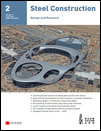
Steel Construction-Design and Research
Elevating Engineering Standards through Steel InsightsSteel Construction-Design and Research is a premier journal published by ERNST & SOHN, focusing on the latest advancements and research within the field of steel construction and structural engineering. With an ISSN of 1867-0520 and E-ISSN 1867-0539, this journal serves as a vital resource for engineers, researchers, and academics committed to enhancing the design and performance of steel structures. Located in the United States, its reputation is bolstered by its impressive standing in various Scopus categories; it ranks in the Q2 quartile for Building and Construction, Civil and Structural Engineering, Mechanics of Materials, and Metals and Alloys as of 2023. This journal is particularly significant as it captures high-quality research spanning critical years from 2011 to 2012 and 2014 to 2024, fetching valuable insights into the evolving methodologies and applications in steel construction. Although it does not operate under an Open Access model, its rigorous peer-review process ensures that contributors deliver top-tier research, making it an essential publication for anyone engaged in the field.
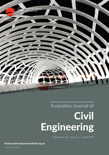
Australian Journal of Civil Engineering
Innovating Infrastructure for TomorrowThe Australian Journal of Civil Engineering, published by Taylor & Francis Ltd, stands as a pivotal platform within the field of civil and structural engineering. With an ISSN of 1448-8353 and an E-ISSN of 2204-2245, this journal consistently delivers high-quality research and innovative practices from both established and emerging scholars in the discipline. Recognized in the Q2 category for Civil and Structural Engineering in 2023, it holds a respectable position, ranking 146 out of 379 within its field according to Scopus, which places it in the 61st percentile. Converging valuable insights from 2011 through 2024, the journal encompasses a broad scope of topics, including sustainable infrastructure, innovative materials, and advanced construction techniques, thereby addressing contemporary challenges faced by engineering professionals. Though it is a traditional publication without open access options, the quality of the research featured ensures that it remains an essential resource for academics, practitioners, and students striving to enhance their knowledge and contribute to the dynamic field of civil engineering.
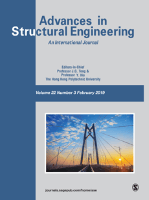
ADVANCES IN STRUCTURAL ENGINEERING
Unveiling Breakthroughs in Structural EngineeringADVANCES IN STRUCTURAL ENGINEERING, published by SAGE PUBLICATIONS INC, is a leading journal dedicated to the advancement of knowledge in the fields of Building and Construction, as well as Civil and Structural Engineering. With a solid impact factor and a commendable Scopus ranking (Rank #60 in Building and Construction, Rank #105 in Civil and Structural Engineering), this journal stands at the forefront of academic research, providing a platform for high-quality articles that contribute significantly to the discipline. Covering a range of topics from innovative construction techniques to sustainable engineering practices, the journal aims to foster collaborative dialogue among researchers, industry professionals, and students alike. As of 2023, it boasts impressive category quartiles, ranking Q1 in Building and Construction and Q2 in Civil and Structural Engineering. ADVANCES IN STRUCTURAL ENGINEERING is a vital resource for those looking to stay abreast of emerging trends and groundbreaking developments in structural engineering, promoting an environment of continuous learning and application of best practices. With a convergence of research from 1999 to 2024, the journal not only emphasizes theoretical frameworks but also bridges the gap between academia and practical application in engineering projects.

Innovative Infrastructure Solutions
Leading the Charge in Sustainable Engineering Practices.Innovative Infrastructure Solutions is a leading academic journal published by Springer International Publishing AG, focusing on pioneering advancements in the fields of building and construction, civil and structural engineering, and environmental engineering. With an impact factor that reflects its significant role in the academic community, this journal serves as a vital platform for researchers, professionals, and students to disseminate groundbreaking studies and novel methodologies spanning diverse engineering disciplines. Since its inception in 2016, Innovative Infrastructure Solutions has steadily positioned itself within the Q2 category across several fields, including geotechnical engineering and engineering geology, as recognized in the 2023 quartiles. This reputable journal, accessible from Switzerland, not only emphasizes collaboration and knowledge exchange but also empowers innovators in infrastructure development globally. Whether you're contributing to a research project or seeking the latest findings, Innovative Infrastructure Solutions remains essential for anyone invested in advancing sustainable infrastructure solutions.